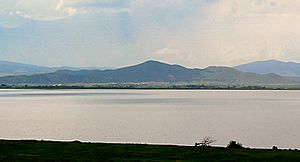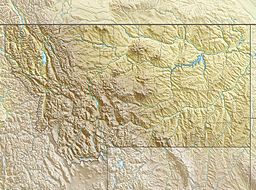Scratchgravel Hills facts for kids
Quick facts for kids Scratchgravel Hills |
|
|---|---|

Scratchgravel Hills as viewed from Lake Helena
|
|
| Highest point | |
| Elevation | 5,233 feet (1,595 m) |
| Geography | |
The Scratchgravel Hills are a small group of hills located northwest of Helena in Lewis and Clark County, Montana. These hills stand about 5,233 feet (1,595 meters) tall. They offer a great chance to learn about rocks, plants, and the history of the land.
Contents
Exploring the Scratchgravel Hills
The Scratchgravel Hills are a unique part of Montana's landscape. In recent years, more homes and buildings have been built near the hills. This development has sometimes led to a drop in the water level in the area.
What are the Hills Made Of?
The top layers of the Scratchgravel Hills are made of soil and rocks that have been moved by water. These are called alluvial deposits. Underneath these layers, you'll find very hard, strong rocks called granite. These granite rocks have cracks or breaks in them, which geologists call faults. These faults show how the Earth's crust has moved over millions of years.
Ancient Rocks
In the northern part of the hills, you can find different kinds of layered rocks. These include shale, sandstone, and limestone. These rocks are incredibly old, dating back to a time called the Algonkian (or Belt) age. Nearby granite has changed these rocks over time, turning them into new types like quartz-mica schist. In the southern and central parts of the hills, the main rock type is quartz monzonite, which is similar to granite.
A History of Mining
From the late 1800s through the 1930s, there was a lot of mining activity in the Scratchgravel Hills. People were looking for valuable minerals and metals hidden within the rocks. This mining played a big part in the history of the area.
Plants and Wildlife
The Scratchgravel Hills are home to various plants. You can often see the beautiful bitterroot flower, which is the state flower of Montana. Many conifer trees, like pines and firs, also grow in the area. These plants provide homes and food for local wildlife.


